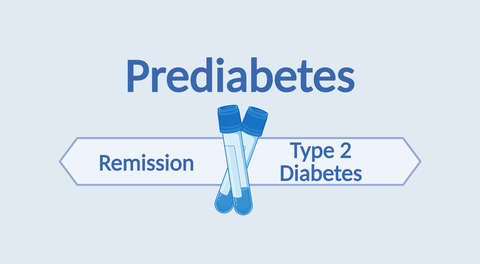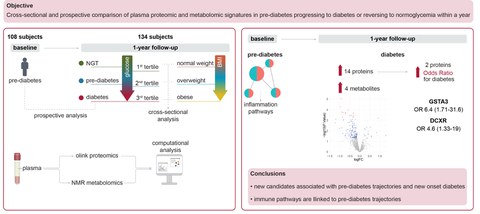Jan 07, 2025
Identification of novel marker candidates associated with the progression of prediabetes to diabetes or its remission to normoglycemia
People with prediabetes often develop diabetes, but many of them manage to reverse to normoglycemia. What determines these distinct outcomes? Can we identify biomarkers to predict the different trajectories of prediabetes? To address the questions above, researchers from the Paul Langerhans Institute Dresden of the German Center of Diabetes Research (DZD) and other collaborators made use of the DZD multicenter study PLIS (Prediabetes Lifestyle Intervention Study) to compare the proteomic and metabolomic signatures of patients with prediabetes following opposite trajectories, i.e. progressing to diabetes versus reversing to normoglycemia. The outcome of this work has now been published in the renowned journal Diabetes Care.
The progression of prediabetes to type 2 diabetes has been associated with pancreatic beta cell dysfunction, whereas its remission to normoglycemia has been related to improvement of insulin sensitivity. To understand the mechanisms and identify potential biomarkers related to prediabetes trajectories, the researchers conducted an explorative case-control study with participants from the PLIS study to compare the proteomic and metabolomic profile of people with prediabetes progressing to diabetes or reversing to normoglycemia within one year.
The team, led by Prof. Nikolaos Perakakis, included in the analysis 1389 proteins and 152 metabolites from plasma samples of individuals in prediabetes state, as well as one-year later, when some of the individuals have reversed to normoglycemia, while others have progressed to diabetes. Significant differences were found in 14 proteins in new-onset diabetes compared to normoglycemia, with six of them being reported for the first time. Elevated concentrations of two of the proteins Dicarbonyl/L-xylulose reductase (DCXR) and Glutathione S-transferase A3 (GSTA3) at prediabetes state were associated with profoundly increased risk for developing diabetes one year later.
Another aspect of the study highlighted the role of inflammation and immune system pathways in glucose homeostasis. Here the scientists found that pathways related to leukocyte chemotaxis, chemokines signaling, cytokine interactions and immune responses to infections were associated with prediabetes progressing to diabetes.
Metabolomic signatures in new-onset diabetes were characterized by increased concentrations of intermediate density lipoproteins, branched-chain amino acids, apolipoprotein A2 and glutamate. Metabolomic and proteomic signatures differentiating between prediabetes trajectories correlated stronger with markers of insulin sensitivity and to a lesser extent with markers of beta cell function.
“We were able to successfully identify new candidates associated with the progression of prediabetes to diabetes or vice versa as well as that we were also able to show that pathways which are regulating immune responses are strongly associated with prediabetes trajectories”, summarizes Prof. Perakakis. “Now, the new candidate proteins may in the future serve as biomarkers of prediabetes trajectories or targets for assessing their role in glucose homeostasis in mechanistic studies.”
Original Publication:
Barovic M, Hahn JJ, Heinrich A, Adhikari T, Schwarz P, Mirtschink P, Funk A, Kabisch S, Pfeiffer AFH, Blüher M, Seissler J, Stefan N, Wagner R, Fritsche A, Jumpertz von Schwartzenberg R, Chlamydas S, Harb H, Mantzoros CS, Chavakis T, Schürmann A, Birkenfeld AL, Roden M, Solimena M, Bornstein SR, Perakakis N. Proteomic and Metabolomic Signatures in Prediabetes Progressing to Diabetes or Reversing to Normoglycemia Within 1 Year. Diabetes Care. 2025 Jan 2:dc241412. doi: 10.2337/dc24-1412.
About the PLIS study:
Conventional lifestyle intervention is not sufficient to prevent type 2 diabetes in all people with prediabetes. Only individually tailored prevention can be effective here. In the completed multicenter Prediabetes Lifestyle Intervention Study (PLIS), the DZD set itself the goal of developing such personalized preventive measures. After extensive phenotyping, the PLIS study participants underwent different lifestyle programs with nutritional counseling and supervised physical activity. 1,145 patients were recruited for the PLIS study. To scientifically follow up this valuable cohort, the follow-up of the study participants was extended to a long-term observation over a period of 12 years after the intervention. Cluster analyses of the PLIS study identified first subtypes of prediabetes that have a particularly high risk of secondary diseases.


